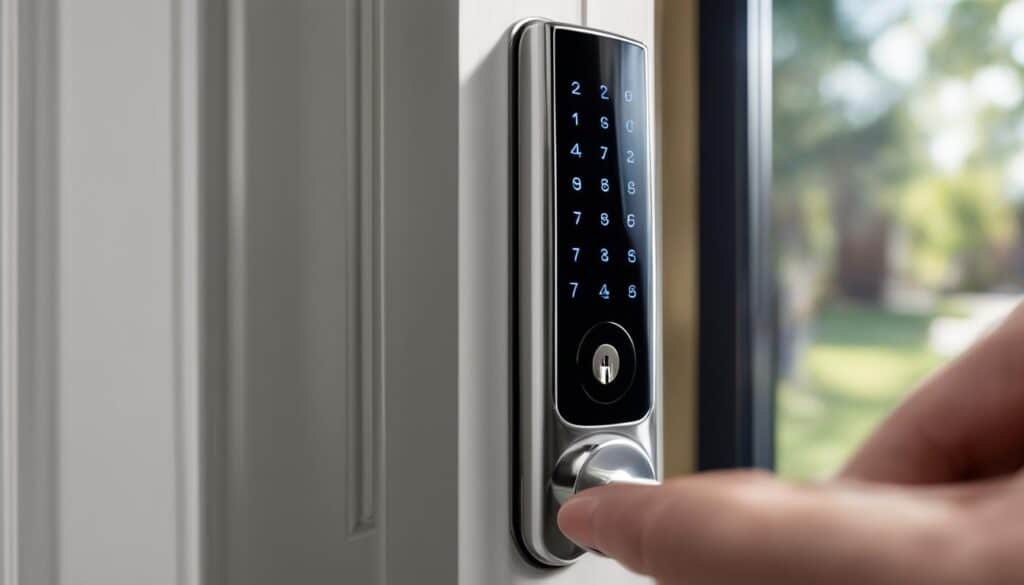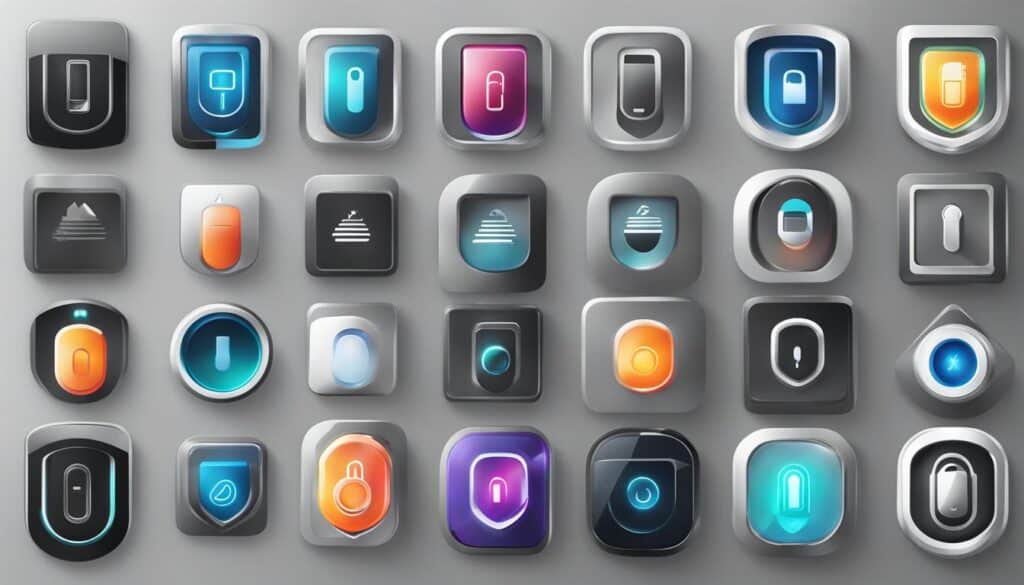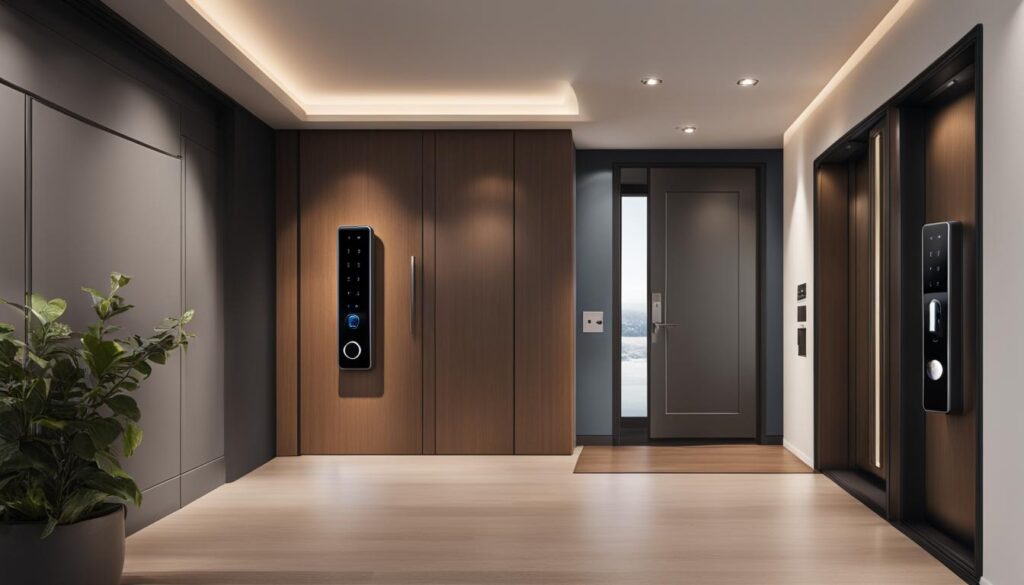As technology continues to advance, so does our ability to secure our homes. Smart locks have revolutionized home security by offering keyless entry technology and enhanced access control. Whether you’re looking to upgrade your home security or simply want the convenience of keyless entry, selecting the best smart lock is crucial. In this guide, I’ll walk you through the key factors to consider, the different types of smart locks available, and the modes of access they offer. By the end, you’ll be equipped with the information needed to make an informed decision.
Table of Contents
Key Takeaways:
- Choosing a smart lock is an important decision for enhancing home security and convenience.
- Consider factors such as lock type, modes of access, platform compatibility, and security features.
- Popular smart lock brands include Yale, Wyze, August, Ultraloq, and Kwikset.
- Read smart lock reviews and compare features to find the best fit for your needs.
- Ensure the smart lock is compatible with your preferred smart home platform, such as Amazon Alexa, Google Home, Apple HomeKit, or Samsung SmartThings.
Types of Smart Locks – Full Deadbolt or Retrofit
When it comes to smart locks, there are two main types to consider: full deadbolt locks and retrofit locks. Understanding the differences between these options will help you make an informed choice for your home security needs.
Full Deadbolt Locks
Full deadbolt locks offer a comprehensive solution for upgrading your existing lock system. These locks replace the entire lock, including the interior thumbturn, exterior keyhole, and deadbolt mechanism. By installing a full deadbolt lock, you get the benefit of keyless entry technology and enhanced security.
One popular example of a full deadbolt lock is the August Wi-Fi Smart Lock Pro. This smart lock not only provides keyless entry but also integrates with other smart home devices for a seamless connected home experience.
Retrofit Locks
Retrofit smart locks, on the other hand, work with your existing lock hardware and do not require the replacement of the entire lock. This makes retrofit locks a suitable choice for situations where completely replacing the lock is not feasible or desirable, such as in rental apartments or older homes with unique lock mechanisms.
An excellent example of a retrofit lock is the Yale Assure Lock SL. This sleek and modern lock is designed to fit on standard deadbolt doors without the need for any additional modifications or alterations.
Comparison Table
| Full Deadbolt Locks | Retrofit Locks | |
|---|---|---|
| Replacement | Replaces entire lock | Works with existing lock hardware |
| Keyless Entry | ✓ | ✓ |
| Interior Thumbturn | Replaced | Retained |
| Exterior Keyhole | Replaced | Retained |
| Lock Mechanism | Replaced | Retained |
As seen in the table above, full deadbolt locks replace the entire lock system, including the interior thumbturn, exterior keyhole, and lock mechanism. Retrofit locks, on the other hand, work with your existing lock hardware and retain the original thumbturn, keyhole, and lock mechanism.

When choosing between full deadbolt and retrofit locks, consider factors such as the level of security you require, the compatibility with your existing lock, and the specific needs of your home.
Modes of Access for Smart Locks
Smart locks offer a variety of convenient modes of access, allowing you to secure and unlock your home with ease. Whether you prefer wireless control, keyless keypad entry, or even biometric scanning, there are options available to suit your needs.
One of the most popular modes of access for smart locks is wireless lock and unlock functionality using a smartphone app. With this feature, you can easily control your smart lock from anywhere, whether you’re at home or on the go. Simply use the app to lock or unlock your door, providing you with peace of mind and added convenience.
For those who prefer a more traditional approach, smart locks with keypads offer an additional layer of access. These keypads allow you to enter a unique code to unlock your door, eliminating the need for a physical key. This feature is especially useful for sharing access with family members, friends, or contractors, as you can easily provide them with a temporary code.
Advanced smart locks may also feature touch sensitivity or fingerprint scanning capabilities. By simply placing your finger on the designated area of the lock, you can quickly and securely unlock your door. This biometric technology provides an added layer of security, ensuring that only authorized individuals can gain access to your home.
Moreover, Apple’s Home Key feature offers a seamless integration between your smart lock and your Apple devices. By storing a digital house key in your Apple Wallet, you can easily access your home with a compatible smart lock. This feature enhances convenience and eliminates the need for physical keys or access codes.
With these various modes of access, smart locks offer flexibility and convenience when it comes to securing your home. Whether you prefer wireless control, keypad entry, or biometric scanning, there is a smart lock option that suits your needs.
Example Table: Features of Smart Lock Modes of Access
| Mode of Access | Description |
|---|---|
| Wireless Lock and Unlock | Control your smart lock using a smartphone app for convenient access from anywhere. |
| Keypad Entry | Enter a unique code on a keypad to unlock your door, eliminating the need for a physical key. |
| Touch Sensitivity | Unlock your door by touching a designated area on the smart lock, providing quick and secure access. |
| Fingerprint Scanning | Utilize biometric technology to unlock your door using a registered fingerprint, enhancing security. |
| Apple Home Key | Store a digital house key in your Apple Wallet for seamless access to your compatible smart lock. |

Platform Compatibility and Integration
When choosing a smart lock, it is crucial to consider platform compatibility and integration. The market offers various smart home platforms, including Amazon Alexa, Google Home, Apple HomeKit, and Samsung SmartThings, each with its own unique features and benefits. Ensuring that your selected smart lock is compatible with your preferred platform will allow for seamless integration and a better user experience.
Some smart locks may require additional devices, such as a hub, to establish connectivity. These hub devices act as intermediaries between the smart lock and the larger smart home platform, enabling communication and control. For example, a Bluetooth smart lock may need a Wi-Fi bridge or a specific hub device that supports the desired platform.
| Smart Home Platform | Hub Device |
|---|---|
| Amazon Alexa | Amazon Echo or Echo Plus |
| Google Home | Google Nest Hub or Google Nest Hub Max |
| Apple HomeKit | Apple TV, HomePod, or iPad |
| Samsung SmartThings | Samsung SmartThings Hub |
Remember, compatibility with your chosen platform and the availability of hub devices may vary across different smart lock models. It is essential to research and ensure that your smart lock of choice aligns with your specific platform requirements and integrates smoothly into your existing smart home ecosystem.
Example of Seamless Integration
With Apple HomeKit compatibility, you can control your smart lock using Siri voice commands or through the Apple Home app on your iPhone or iPad. By connecting your compatible smart lock and Apple device, you can easily manage access to your home while enjoying the convenience of automated actions and personalized scenes.
Conclusion
When it comes to enhancing your home security, choosing the right smart lock is crucial. Consider factors such as the type of lock, modes of access, platform compatibility, and security features before making your decision.
Some of the top-rated smart locks in the market include the Yale Assure Lock 2, Wyze Lock Bolt, August Wi-Fi Smart Lock, Ultraloq U-Bolt Pro, and Kwikset Halo Touch. These smart locks offer innovative features and have received positive reviews from users.
To find the best smart lock for your specific needs, compare the features, pricing, and reviews of these top-rated options. It’s important to ensure that the smart lock you choose aligns with your home security requirements and integrates seamlessly with your preferred smart home platform.
By investing in the best smart lock, you can enjoy convenient keyless entry, advanced access control, and peace of mind in knowing that your home is secure. Make an informed decision and prioritize your home security with the top rated smart locks available in the market today.
FAQ
What factors should I consider when selecting a smart lock for enhanced home security?
When choosing a smart lock, consider factors such as the type of lock, modes of access, platform compatibility, security and privacy features, and design considerations.
What are the two types of smart locks available?
Smart locks come in two types – full deadbolt and retrofit. Full deadbolt locks replace the entire existing lock, while retrofit locks work with existing lock hardware and do not require the replacement of the entire lock.
What modes of access do smart locks offer?
Most smart locks allow wireless lock and unlock functionality using a smartphone app. Some smart locks also feature keypads for coded entry, and advanced smart locks may have touch sensitivity or fingerprint scanning capabilities. Apple’s Home Key feature allows for storing a digital house key in your Apple Wallet for easy access.
How important is platform compatibility for a smart lock?
It is important to consider the platform compatibility of a smart lock. The most popular smart home platforms are Amazon Alexa, Google Home, Apple HomeKit, and Samsung SmartThings. Ensure that the smart lock you choose is compatible with your preferred platform.
What are some popular smart locks available in the market?
Some popular smart locks include the Yale Assure Lock 2, Wyze Lock Bolt, August Wi-Fi Smart Lock, Ultraloq U-Bolt Pro, and Kwikset Halo Touch. Compare the features, pricing, and reviews to find the best smart lock for your specific requirements.


